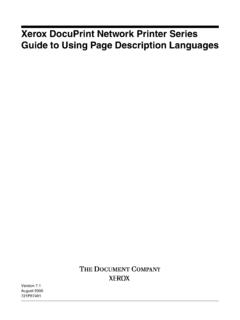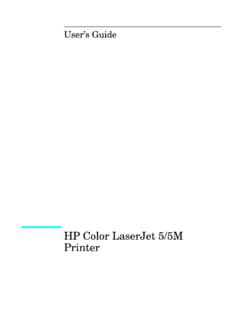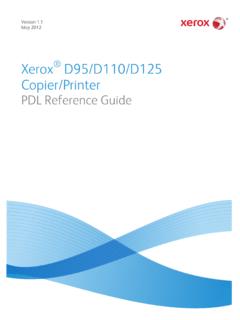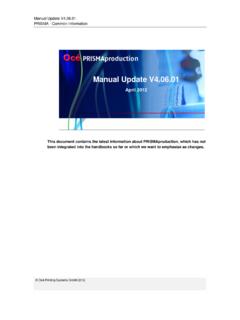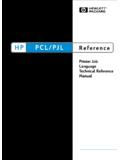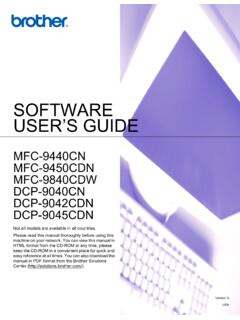Transcription of Universal Serial Bus Device Class Definition for Printing ...
1 Universal Serial BusDevice Class DefinitionforPrinting DevicesVersion 2000 USB Device Class Definition for Printing DevicesPage iiVersion IPBK evin PackardJeanette PackardTodd PackardKaren Van Der PackardPaul PackardErik W. DesignDavid DesignEric T. TechnologiesKevin Computer ConsultantsJohn Technologies Technology Enablers, Nine EngineeringLarry A. Editor, version TechnologiesCurtis Stevens, former Device Class Definition for Printing DevicesVersion iiiUSB Communication Device Class Definition for printer DevicesCopyright 1996 - 2000, USB Implementers rights PROPERTY DISCLAIMERTHIS SPECIFICATION IS PROVIDED AS IS WITH NO WARRANTIES WHATSOEVER INCLUDINGANY WARRANTY OF MERCHANTABILITY, FITNESS FOR ANY PARTICULAR PURPOSE, OR ANYWARRANTY OTHERWISE ARISING OUT OF ANY PROPOSAL, SPECIFICATION, OR LICENSE IS HEREBY GRANTED TO REPRODUCE AND DISTRIBUTE THIS SPECIFICATION FORINTERNAL USE ONLY.
2 NO OTHER LICENSE, EXPRESS OR IMPLIED, BY ESTOPPEL OROTHERWISE, TO ANY OTHER INTELLECTUAL PROPERTY RIGHTS IS GRANTED OR OF THIS SPECIFICATION DISCLAIM ALL LIABILITY, INCLUDING LIABILITY FORINFRINGEMENT OF PROPRIETARY RIGHTS, RELATING TO IMPLEMENTATION OFINFORMATION IN THIS SPECIFICATION. AUTHORS OF THIS SPECIFICATION ALSO DO NOTWARRANT OR REPRESENT THAT SUCH IMPLEMENTATION(S) WILL NOT INFRINGE other product names are trademarks, registered trademarks, or servicemarks of their respective send comments via electronic mail to Device Class Definition for Printing DevicesVersion vTable of Contents1. INTRODUCTION .. Scope .. Related 12. MANAGEMENT OVERVIEW .. 23. FUNCTIONAL CHARACTERISTICS .. Operational Model .. Interfaces .. Status 44. Standard Requests .. Class -Specific 65. STANDARD Device Descriptor .. Configuration Descriptor .. Interface Descriptors .. Endpoint Descriptors ..1010 USB Device Class Definition for Printing DevicesPage viVersion of TablesTABLE 1 - Class -SPECIFIC REQUESTS.
3 6 TABLE 2 - CAPABILITIES STRING .. 6 TABLE 3 - printer PORT 4 - Device 5 - CONFIGURATION DESCRIPTOR ..99 TABLE 6 - INTERFACE 7 - ENDPOINT 8 - BULK OUT ENDPOINT DESCRIPTOR ..1111 TABLE 9 - BULK IN ENDPOINT DESCRIPTOR ..1111 USB Device Class Definition for Printing DevicesVersion Universal Serial Bus (USB) is a communications architecture that gives a PC the ability to interconnect avariety of devices via a simple four-wire cable. One such Device is the printer . Traditionally, printers have beeninterfaced using the following technologies: Unidirectional parallel port Bi-directional parallel port Serial port SCSI port Ethernet/LANT here are other, more sophisticated printer interfaces, but the ones previously listed are the most popular. USBoffers a much greater throughput capability than the Serial port and is comparable in speed to the parallel port. Thismakes both parallel and Serial printers good candidates for interfacing with document fully describes the printer Class of USB devices , including: The printer Class subclass and protocol.
4 Device , configuration, interface, and endpoint descriptors. The USB standard requests used by printer devices . The USB Class -specific requests and responses used by printer purpose of this document is to describe configuration, interface, and endpoint descriptors as well as acommunications protocol for operating system, BIOS, and peripheral designers implementing support for USBprinters. These definitions allow an operating system designer to design a single software package to support agiven Class or subclass of Device . These definitions also provide a framework for designing the peripherals in eachclass or DocumentsThe printer Class defines an architecture for delivering existing printer -command sets to a USB printer . Thefollowing documents include relevant USB publications as well as some popular printer PDLs and PCPs: Universal Serial Bus Specification, revision (also referred to as the USB Specification). Inparticular, see Chapter 9, USB Device Framework.
5 This specification is available on the World WideWeb site PostScript language Reference Manual, Second Edition. Addison-Wesley Publishing Company, : 0-201-18127-4. PCL / PJL technical Reference Package. HP part number 5961-0937. Hewlett-Packard Company. 1-800-227-8164 or Includes: PCL 5 language technical Reference Manual and printer Job language technical ReferenceManual IEEE 1284-1994 Standard Signaling Method for a Bidirectional Parallel Peripheral Interface for PersonalComputers. This specification is available from the IEEE ( ).Note This specification does not define Page Description Languages (PDL) or printer Control Protocols (PCP).This specification defines interfaces that are intended to support existing PDLs and Device Class Definition for Printing DevicesPage 2 Version IEEE Standard for Data delivery and logical channels for IEEEstd. 1284 interfaces. This specification is available from the IEEE ( ). OverviewPrinting devices are unique because they convert a Page Description language (PDL) into a human-readable printedpage.
6 Printers require a mechanism for sending these PDLs, in the form of data, to the printer ; and a mechanism forreturning status information from the printer . Conventional parallel printers use a bi-directional printer port tosupport these languages. USB uses a Bulk OUT endpoint to send the data to the printer , and a Bulk IN endpoint forstatus and other data received from the printer . The Bulk IN endpoint is sufficient for status data retrieval becausein today s existing implementations, the parallel status information is retrieved via polling mechanisms in the PDLs allow the printer to return large amounts of data, such as font definitions. If the printer implements thiscapability, it returns the data on the same Bulk IN endpoint which is typically used for examples of PDLs are PostScript and Hewlett Packard Graphics language (HPGL). Examples of PrinterControl Protocols (PCP) are Hewlett Packard PJL, IEEE , and Microsoft Windows Printing System (WPS).
7 The USB Device Class Definition for Printing devices provides a mechanism for administering all of the previouslylisted printers report their capabilities via the Class -specific command GET_DEVICE_ID which returns a Device IDstring that is compatible with IEEE-1284. This string lists all the PDLs and PCPs supported by the CharacteristicsThis section describes the functional characteristics of printers, including: The operational model Interfaces Model Printers have two different types of commands: those that transfer data, and those that control the USB interface orprinter interface. The host prints something on a printer by delivering data on the Bulk OUT endpoint. This datamay take the form of PostScript, HP PCL, or any other PDL. This data may also be encapsulated in a PCP, such asIEEE , or something that is vendor-specific. In addition, the data may also be simple text, or it may be aproprietary PDL. The printer can respond periodically on the Bulk IN endpoint with status regarding the data it isreceiving, or because of an asynchronous event.
8 A typical printed page takes the following sequence:USB Device Class Definition for Printing DevicesVersion 3 Figure 1 Printing a Page The PDL data is sent to the Device on the Bulk OUT pipe. If the Device uses a PCP, then the PDL is encapsulated inthe PCP; the Bulk IN pipe is used for any responses, such as errors and printer status as defined in the PCP. For aunidirectional interface, the status is retrieved by issuing a GET_PORT_STATUS on the default pipe, and the statusis returned on the default pipe. The second type of command controls the USB interface. These commands include the standard requests, such asGET_DESCRIPTOR and SET_CONFIGURATION. These requests are described in Chapter 9, USB DeviceFramework, in the Universal Serial Bus Specification. printer -specific commands, such as SOFT_RESET orGET_PORT_STATUS, are included as well. The following diagram shows a control command sequence of atypical interface: Figure 2 Interface Control Command HostDeviceDevice/Interface CommandsDefault Pipe Commands sent on the default pipe report information back to the host on the default pipe.
9 If an error occurs, theygenerate a standard USB error status. This applies to all Class -specific requests in addition to the general requestsdescribed in Chapter 9, USB Device Framework, in the Universal Serial Bus Specification. HostDeviceDevice/Interface CommandsDefault PipeHostDeviceHostDevicePDL or PCP DataBulk OUT PipePDL or PCP ResponseBulk IN Pipe (Optional)USB Device Class Definition for Printing DevicesPage 4 Version Printers support three possible interfaces, but only one can be enabled at any given time. The interfaces are definedas follows: Unidirectional Interface. The unidirectional interface supports only the sending of data to the printer via aBulk OUT endpoint. Status data that is compatible with a standard PC parallel port is retrieved via theclass-specific command GET_PORT_STATUS over the default pipe. For more information about statusdata, see Section , GET_PORT_STATUS. Bi-directional Interface. The bi-directional interface supports sending data to the printer via a Bulk OUTendpoint, and receiving status and other information from the printer via a Bulk IN endpoint.
10 Status datathat is compatible with a standard PC parallel port is also available when this interface is in use via theGET_PORT_STATUS Class -specific command over the default pipe. For more information about statusdata, see Section , GET_PORT_STATUS. IEEE compatible Bi-directional Interface. The interfacesupports sending data to the printer via a Bulk OUT endpoint, andreceiving status and other information from the printer via a Bulk INendpoint, just as the bi-directional interface does. The additionally specifies that data will be transmitted to andfrom the Device using the protocol. The protocol isdefined by the IEEE Standard for Data delivery and logicalchannels for IEEE std. 1284 interfaces, version Thisspecification is pending final specification is intended only for the Definition of USB printer devices using for communications. Thedefinition of multi-function devices using for communications is outside the scope of this of these interfaces shall be supported.
